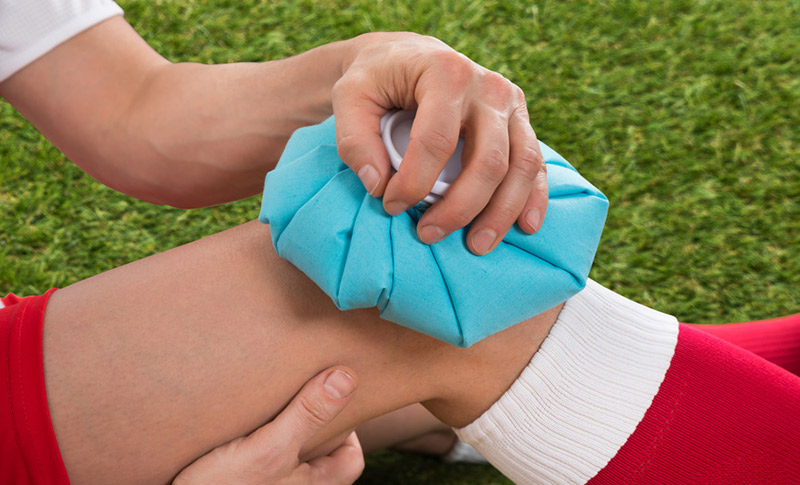We’ve all been in this position at some point in our lives: the Olympics are underway and we’re oohing and aahing over the incredible feats being performed by the athletes, so we’re inspired with a desire to emulate them. Soon, we’re lacing up our running shoes and setting out on the roads or diving into the pool, even though we may not have participated in either of those sports in ages.
Afterward, of course, our bodies let us know how foolish we have been. If we’re lucky, we may get away with sore muscles; if things go badly, we may suffer a sports injury that needs treatment and healing.
The Most Common Weekend Warrior Injuries
Of course, it’s not only during the Olympics that these unfortunate injuries occur. As we age, those of us who participate in a sport on the weekend, but are sedentary throughout the week, are ripe for sports injuries.

Weekend warriors, as they’re commonly called, don’t use their muscles regularly, so it’s no surprise their bodies aren’t prepared for the strain put upon them when it’s time for pickup hockey or the weekly softball outing.
Among the common injuries from weekly outings are:
- Ligament sprains
- Stress fractures
- Muscle strains
- Tendinitis
- Shin splints
- Runner’s knee
- Tennis elbow
How to Prevent Weekend Warrior Injuries
Most weekend warrior injuries are preventable. There’s no need to put your body at risk of injury if you approach physical activity properly.

Here are some tips to prevent injury while you enjoy your athletic pursuits:
- Challenge your body: Professional athletes train regularly to stay at the top of their games, so why should you expect to jump onto the ice one night each week and instantly perform like Sidney Crosby? Nor can you ever recapture your glory days as a high school basketball star – youth has its advantages. However, there is no reason you can’t perform well as long as you prepare. Try to challenge your body at least twice a week by using the muscles you’ll be using in the game or the competition so they are ready for the workload you will expect them to undertake.
- Bet on balance: Once you’ve decided to exercise more than once a week, employ some balance in the activities you choose. Include cardiovascular activity, stretching and weight training in your routine. Cross-training can prevent injuries that result from overuse: relying on the same group of muscles and tendons regularly.
- Slow and steady: As much as you’d like to run a marathon the week after you’ve started jogging, it’s unrealistic and dangerous. Begin with a level of intensity that is manageable and increase it by 10 per cent weekly, allowing your body to become accustomed to the new level of activity.
Stretching, Hydration and Equipment
Stretching is important for everyone over the age of 30. Muscles get tight, especially leg muscles. If they are overused, the body will compensate by relying on other areas, such as the lower back.

- Get warm: Stretching before your activity may relax key muscles, shutting them down so that they are susceptible to strains; they will be less receptive to dynamic movements. Instead, consider an active warm-up. Hockey players take their warm-up skate before a game, and you should also prepare your body for activity with movements that increase the blood flow to soft tissues while activating muscles. Examples of active warm-up moves include high knees, shuffling, throwing and jogging.
- Hello, hydration: People generally don’t drink enough fluids during the day, so it’s likely that you’ll begin your athletic pursuit at a disadvantage. Research has shown that even a five per cent loss of bodily water content can have a major impact on agility, reaction time and speed. Don’t wait until you are thirsty to drink – by the time you notice your thirst, you’re already dehydrated. Instead, get in the habit of drinking water or other replenishing fluids at regular intervals throughout your day. Soon, it will seem like a no brainer.
- Equip yourself: Ensure that you have the proper equipment for the sport you are undertaking, and make sure the equipment is in good shape so that it doesn’t contribute to possible injury. Shoes, for instance, break down and can’t offer the necessary foot stability. They can also lead to foot injuries if your wear pattern results in a compromised foot position. The rule of thumb – or foot, in this case – is to get new running shoes after about 800 kilometres (500 miles) of use.
How to Deal with a Weekend Warrior Injury
If you have ventured onto the playing field before reading this article, you may already have first-hand knowledge of weekend warrior injuries.

If you do suffer an injury while playing sports, follow the RICE method:
- Rest the injured area to allow for healing.
- Ice the injury on and off for 10 to 15 minute periods during the day to keep swelling down and alleviate pain.
- Apply compression to the affected area.
- Elevate the injured area above heart level to prevent or decrease swelling.
If the RICE method doesn’t yield results or you are still in pain, don’t shrug off the injury.
Physiotherapists can do movement assessments, provide treatment and design appropriate home exercise programs to assist your healing. There’s no need to suffer endlessly as a result of being a weekend warrior!
